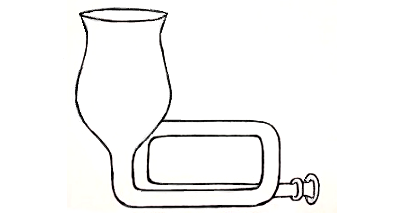Terminology
Shaken-not-stirred is also know as SNS.
What you need
- A little pot
- Dry malt extract (DME) 100g
- 4 liter (or larger) sealable container/bottle
- Yeast nutrient (optional but recommended)
- Yeast
- Water (in case you forgot!)
A Word on Size
The size of your container (bottle) should be 4-5 liters if making a 1 liter starter. Shoot for the 4:1 ratio. This is to ensure adequate surface area. A lot of surface area provides enough space to get good foam. A lot of foam means you’ve got a lot of oxygen for the yeasties.
Mix, Boil, and Chill

I boil for about 5 minutes and then chill in a water bath. I like to add a pinch of yeast nutrient preboil. Chill to the same temperature you plan to use for fermenting the upcoming brew.
How Much DME and Water?
1 liter of water and 100 grams of dry malt extract (DME) will give a gravity of 1.035. You can also use the more standard 1 liter and 115 grams for a gravity of 1.040.
Sanitize, Add, Shake, and Pitch…

Shake That Thing
Be sure to shake until almost all the liquid has turned into foam (90%). I find it’s helpful but not entirely necessary to listen to some bump’n tunes. Try “Get Busy” by Sean Paul.
*For the yeast’s sake, PLEASE, shake first, then add them into your container. They’ll thank you later.
Let the starter “go” at the same temperature or a litter cooler than your planned fermentation temp. The goal is to pitch it when it is at high krausen. This can be a bit hard to time until you’re familiar with the yeast and process.
How Much Yeast?
Denny Conn said he used one Wyeast “smack pack” to brew his Noti Brown Ale that weighs in at 1.065-ish. He said he had great results. A Wyeast smack pack has 100 billion cells.
*As noted in the comments, the amount of yeast is not as important. Use “enough” yeast!
Credit
Thanks to Mark Van Ditta and Denny Conn for coming up with and “propagating” the shaken-not-stirred starter method. You can read more about it on the American Homebrewers Association (AHA) Forum here.
Update 9-24-20
Mark Van Ditta contacted me and he has a new blog post about the SNS method. See it here
Need Supplies?
*I make an affiliate commission if you use and purchase items from the links below
Feel free to comment below





8 thoughts on “Shaken-not-Stirred Yeast Starter (Illustrate Steps for the SNS Method)”
Thanks for helping get the word out! One thing I’d like to mention is forget about cell count! You’ll have plenty. As Mark pointed out, the yeast go “nuclear” when pitched into your wort. Within a few hours you’ll have as many cells as you would if you made a larger starter. And it’s all about yeast vitality, not cell count, anyway.
Denny,
Thanks for the feedback. It makes sense and that’s one less thing to worry about.
Thanks for putting this together. The existing guidance on the web was a bit disorganized IMH) I wasn’t careful putting all the steps together and added the yeast before shaking. I’m sure it was “shear torture” for the yeast 😉 This guide is very clear, I won’t be making that mistake again.
One thing I do wonder about is if a typical yeast package results in overpitching for a typical 5 gallon batch. I’ve heard knowledgable yeast folks say there’s a lot of misinformation out there about how sensitive things are to yeast counts–maybe it’s not a real concern…
Clark, I’d heed the advice of Denny Conn and say that the amount of yeast is less important than the “quality”, at least in the case of brewing a five gallon batch. Of course, the usual consideration of starting gravity and ale vs lager yeast should be taken into account.
I use a 5 L flask. Do I use foil or seal it with a solid bung? If I seal it, won’t the yeast that is producing C02 blow off the cap or bung?
Hi Chris,
Use you bung to plug the flask while shaking, pitch your yeast, then out your foil on the flask. You are correct that the CO2 from the yeast would push your cap off.
When I use a bottle with a cap, I simple ensure that my cap is very loosely screwed on the bottle.
For lager are you fermenting the starter at 52f or something? How does this effect the timing of the whole process?
Jack,
I recommend keeping your starter at the same temp or a touch cooler than your desired fermentation temp. This should help avoid any yeast lag/stress due to, for example, dropping from a higher to a lower temp.
I don’t have personal experience (in memory) using this method for lagers. I’d expect a delay in achieving high krausen but how much will vary strain to strain. That’s my way if saying, I don’t know. Hope that helps.
Test, adjust as need, repeat.